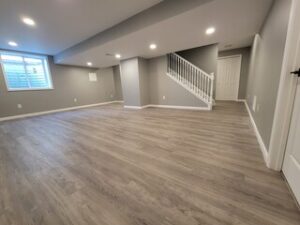Basement Finishing is an excellent way to increase the livable space in your home without the cost and inconvenience of building an addition. It can be done in a variety of ways to create rooms for your family or a specific purpose like a home gym or extra bedroom.

You can choose to use a drop-ceiling, hang drywall or leave the ceiling open for an industrial look. Each option has its own set of installation instructions and difficulty level. Reach out to Basement Finishing Lehi for expert assistance.
One of the primary benefits of a basement remodel is the increased living space it provides. It adds an entire extra floor to your home, giving you plenty of room for a recreation area, entertainment zone, and more. It is also a great way to create an additional bedroom or home office to avoid having to share a single room with your growing family.
With the right design, your new basement can become the ultimate multi-purpose entertainment area or an elegant wine cellar. If you are planning on selling your home in the near future, a finished basement can also boost its resale value and make it more attractive to potential buyers.
Unlike adding an addition to your home, a basement finish is an affordable and effective solution to expand your living space. It can be a bedroom, playroom, exercise room, or a combination of rooms to fit your specific needs and lifestyle. In addition, it can be a perfect place to entertain friends and family, without having to worry about noise disturbing the rest of your home.
A basement finish can be a DIY project, but it is usually best left to professionals. It is a complicated process that requires knowledge of plumbing, electrical, and construction to complete correctly. It also involves working around obstructions like ductwork, water pipes, and gas lines. In addition, it is important to install proper insulation to prevent unwanted heat or cold in your basement.
In addition, a professional will ensure that all the finishing work complies with local and national codes to avoid safety issues. It is also a good idea to have an expert design your basement to make sure it is aesthetically pleasing and functional.
It Adds Value to Your Home
A well-finished basement can increase the value of your home, whether you use it as a playroom for the kids or a place to entertain guests. This extra living space can also add to your family’s quality of life and provide an income-generating option if you choose to rent out the room.
Depending on the area where you live, your finished basement can increase your property’s value by a significant amount. This is because many homebuyers desire basements, especially walk-out basements, which offer easy access to the outdoors. Additionally, since the space is below ground, it doesn’t count toward your home’s square footage, which may help you get a higher return on your investment.
The cost of a basement finish can vary based on how much work is done and the amenities you choose to include. On average, a basement remodel will cost between $5,000 and $20,000, with the majority of costs going towards framing, running whatever mechanicals are necessary, installing wall, ceiling, and floor finishes, and painting or wallpapering.
Before starting your basement renovation, assess your skills and experience to see if it’s a project you can complete yourself or if you need to hire a contractor. You’ll need to have at least basic skills in framing, electrical, plumbing, and drywall if you choose to tackle the project on your own. Otherwise, you’ll want to consult a professional for advice and to make sure your work complies with local codes.
In addition to being a great investment, finishing your basement can improve the overall energy efficiency of your home. Unfinished basements tend to be cold and damp due to lack of insulation, but a finished basement will have insulated walls and floors that will keep the space warm and comfortable. This will also allow you to reduce your energy costs by not overworking the HVAC system in the rest of the house.
The best way to determine if a basement finishing project is worth the investment is to speak with a real estate agent in your area. They can provide you with a rough estimate of your home’s current value and how much you could expect to get when it comes time to sell.
It Adds Comfort to Your Home
A basement finish is a great way to add comfort to your home. It allows you to create a space that fits your family’s needs, such as a bedroom or home theater. You can even turn it into a rental unit to help pay your mortgage.
It is also a more affordable option than moving to a new house. With the current real estate market, it is difficult to find a new home that fits your needs and budget. By finishing your basement, you can add a space that is ideal for your family without the high price tag and stress of moving.
During the basement renovation, you will need to make sure your space is well-insulated. This will ensure that your basement is comfortable year-round, no matter the season. In addition, it will reduce the workload on your heating and cooling systems, which can lead to energy savings over time.
Basement finishing is a complex project that requires specialized knowledge. It involves working around obstacles such as plumbing drains, water lines, electrical wires, and HVAC ducting. It is best to hire a professional design-build company for the job. This will allow you to get the most value from your investment and avoid costly mistakes that could cost you in the future.
If your family is growing, a finished basement can offer a private retreat where your kids can hang out with their friends or do their homework. It can also serve as a guest room for out-of-town visitors.
If you want to transform your basement into a cozy living space, there are many options available to you. You can turn it into a bedroom, family room, game room, or home theater. It is a great place to spend quality time with your loved ones. In addition, a finished basement can provide you with a quiet space to escape from the busy world outside your home. A finished basement is a great addition to your home and can increase its resale value. By adding a bedroom and bathroom, you can significantly improve the comfort of your home and make it more appealing to potential buyers.
It Increases Energy Efficiency
Basement Finishing is a great way to increase energy efficiency in your home. The earth naturally insulates basements, and proper insulation and ventilation help regulate temperatures to ensure a comfortable living space year-round. This can save you money on heating and cooling costs, as well as reduce your carbon footprint.
One of the best parts about a finished basement is that it can be used for anything you want. If you’ve been wishing for a dedicated office, home gym, or craft room, your basement can be exactly what you need to make those dreams a reality. You can also create a family space or even a man cave to enjoy your favorite sports games.
Besides boosting your quality of life, a finished basement can add value to your home, making it an appealing investment if you ever decide to sell your house. In fact, a basement remodel can return on average about 70% of its cost in terms of added home value.
Another benefit of a basement finishing is that it allows you to expand your home without violating zoning restrictions. Unlike a new-build, which requires permits to build additional rooms or levels, you can add a bedroom, bathroom, and kitchenette to your basement and then rent it out for extra income.
If you’re planning to sell your home in the future, a basement remodel will appeal to many potential buyers, especially families with children and people who work from home. You may also be able to attract tenants who are looking for a spacious, safe place to live at an affordable price.
A contractor will start the project by framing walls, installing utilities that run through the wall cavities, and addressing any moisture or waterproofing issues. They will then install drywall and paint, followed by installing flooring, fixtures, and lighting. They can also handle electrical and plumbing projects, ensuring that everything is up to code. By hiring a professional, you’ll avoid the stress of tackling a major renovation on your own and ensure that you end up with a comfortable, functional basement.

